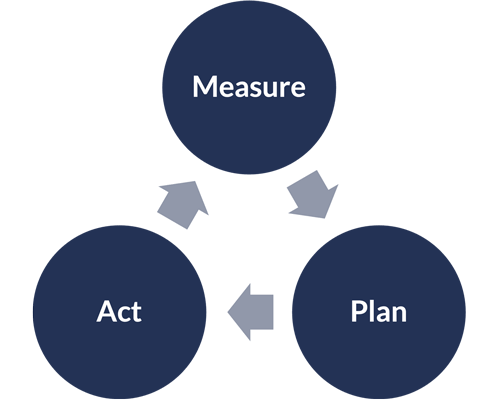How to Improve Marketing Effectiveness and Efficiency in 2024
Unlock the secrets to optimizing marketing performance.
In the late 1800s, John Wanamaker, a pioneer in advertising and the founder of one of the first department stores in the United States, famously lamented, “Half the money I spend on advertising is wasted; the trouble is, I don’t know which half.” Nearly 200 years later, this conundrum still perplexes marketing leaders worldwide. As we begin 2024, the challenge of deciphering marketing effectiveness remains, albeit in a marketing landscape that’s far more complex than Wanamaker could have ever imagined. In this post, you’ll see how to not only measure but also improve both marketing efficiency and marketing effectiveness.
Understanding Marketing Efficiency and Effectiveness
Marketing Efficiency
Improving marketing efficiency is about refining how you do things to drive results. Metrics like Cost per Acquisition and Conversion Rate serve as benchmarks for gauging the efficiency of marketing efforts. The goal is to maximize the output of your marketing efforts.
Here are some examples of how to improve marketing efficiency:
- Lower your Cost-Per-Thousand (CPM) while maintaining the same (or better) reach and frequency
- Minimize shopping cart abandonment in your online store
- Boost the open rates of your email campaigns
- Improve your search engine rankings for specific, targeted keywords
- Increase the Click-Through Rate (CTR) in your paid advertising campaigns
- Reduce the costs of acquiring new customers or leads
Marketing Effectiveness
To increase marketing effectiveness, one must adapt to emerging market trends and changing consumer behaviors. It's about more than just seeing a good return on your marketing spend. Marketing effectiveness is about growing the value of your company by increasing profitability, expanding market share, and strengthening your brand.
“Marketing efficiency is improving how you do the right things. Marketing effectiveness is improving what you do so you do more of the right things.” Tim Rayl
Fractional CMO
Enhancing Marketing Effectiveness in 2024
To realize these goals, focus on refining:
- How you position your brand: Stay ahead by aligning your offerings with the latest market trends and consumer expectations.
- The products or services you offer: Use advanced analytics to understand customer behaviors and preferences. Deep customer insight is essential to improving marketing effectiveness.
- Your target audience: Pinpoint the high value segments - those that value your offerings the most and are willing to pay a premium.
- The messaging you use: Your message should be clear, compelling, and adaptable to stay relevant.
- Your pricing strategy: Employ real-time data for strategic pricing decisions. Consider employing dynamic pricing strategies.
- The ways you promote (through various communication channels): Combine traditional and digital channels for a comprehensive approach to brand building.
- Where you place your products or services (distribution channels): Ensure your products or services are available where your customers are most active.
Take, for example, an investment in an advertising campaign aimed at increasing brand awareness. You might have the perfect mix of messaging, audience, and channels. But if your budget is too small to generate adequate reach and frequency, it may not be worth proceeding, because the investment might not effectively boost brand awareness.
So, to improve marketing effectiveness, you might want to:
- Refine your target audience to a smaller group that can be effectively reached within your budget, while ensuring the audience size is significant enough to be meaningful.
- Consider increasing your budget to ensure your campaign achieves the necessary reach and frequency, provided the company has the resources.
- Redirect your funds to different strategies that could more effectively enhance brand awareness, assuming you have the resources and capability to pursue these alternatives.
Align Metrics with Objectives
To evaluate the success of your marketing in terms of effectiveness and efficiency, you need to select the right metrics. That means choosing metrics that best represent the desired results of a specific campaign or marketing tactic. For example, if your goal is to drive purchase intent for a given product or service, you want to measure more than the number of impressions, clickthrough rate, and CPM. You'd want to measure the change in product page views and events like 'adds to cart', 'checkouts initiated', and 'purchases'. The right metrics are instrumental in guiding decision-making and actions that lead to the success of your brand.
Choose the Right Metrics | |
|---|---|
Marketing Effectiveness (Strategic) | Marketing Efficiency (Tactical) |
| Market Share | Return on Ad Spend |
| Brand Strength | Cost of Acquisition |
| Purchase Intent | Conversion Rate |
| Lifetime Value | Clickthrough Rate |
To ensure you choose the right metrics, answer these questions:
- Which specific metric should be used?
- What makes this metric appropriate for our needs?
- How will this metric help us make better decisions?
- What kind of actions will this metric enable us to take?
- How will this metric be tracked and quantified?
- At what intervals should this metric be assessed?
- Who is responsible for monitoring and reporting this metric?
I prefer to select metrics by mapping each objective, marketing tactic, and metric onto a decision journey framework. This approach ensures that metrics are aligned with objectives. Also, this map becomes an effective tool for helping everyone involved understand what constitutes success.
The Intersection of Effectiveness and Efficiency
Marketing efficiency and marketing effectiveness complement each other. Here are a couple of scenarios to illustrate this:
Picture a situation where the return on investment (ROI) for a previously successful marketing tactic starts to wane. Despite your best efforts to enhance its efficiency, the results aren't improving. It's time to reevaluate its effectiveness. Ask yourself: Is this tactic still appropriate and effective for your current goals?
On the other hand, suppose you've rolled out a new marketing campaign. The initial outcomes are promising, showing good performance. This is the moment to focus on marketing efficiency. Think about ways to fine-tune this tactic to boost its ROI even further.
Steps Forward

- Measure and Benchmark: Regularly assess against industry benchmarks and your past performances.
- Plan with Agility: Be ready to pivot based on real-time data and market trends.
- Action and Adaptation: Implement, learn, and adapt based on the outcomes.
Conclusion: A Continuous Journey
We've come a long way from John Wanamaker's era, yet his dilemma continues to challenge us as modern marketing leaders. But now you are equipped with advanced insights that Wanamaker could only have dreamed of. We've explored how to measure and improve marketing effectiveness and marketing efficiency. By continuously improving each, you'll unlock the secret to optimizing marketing performance.



